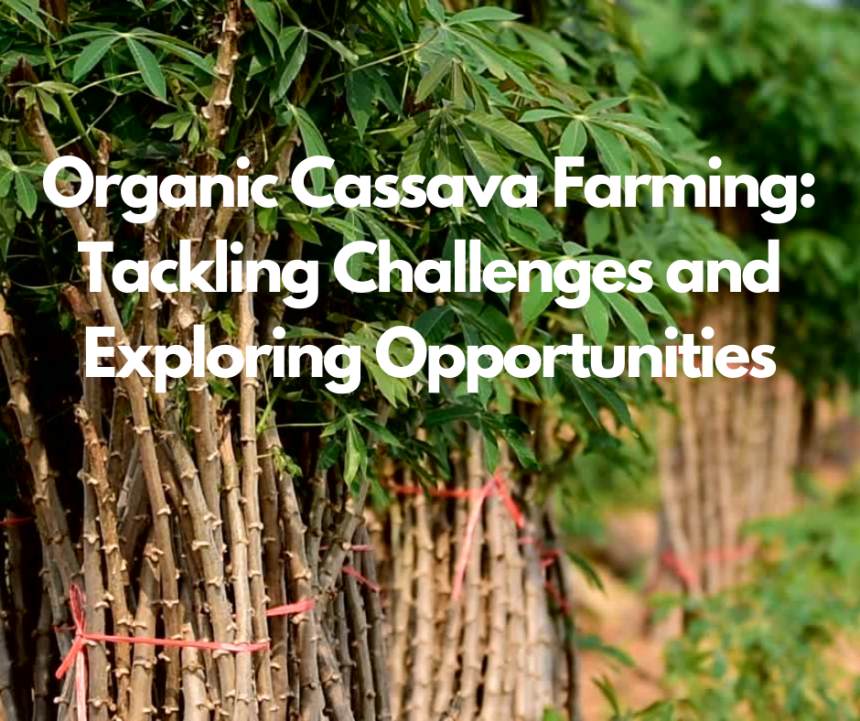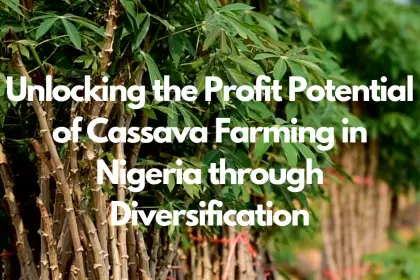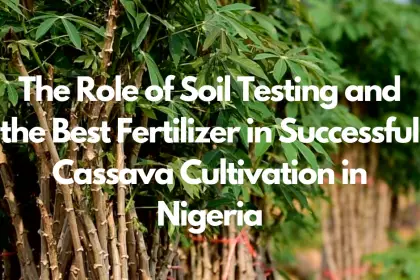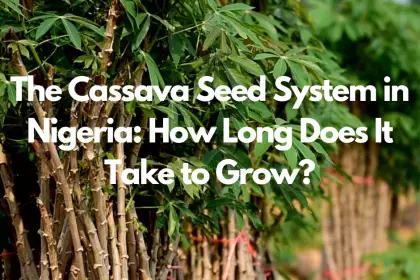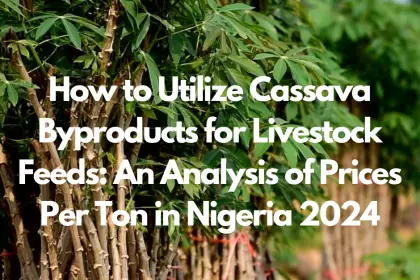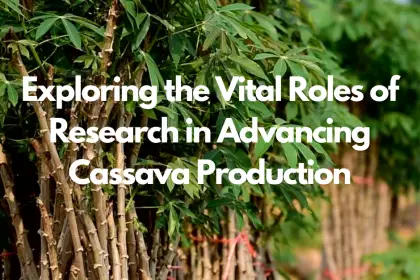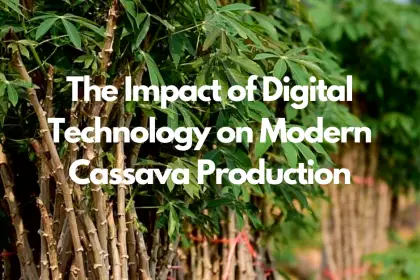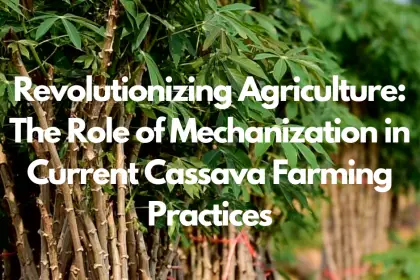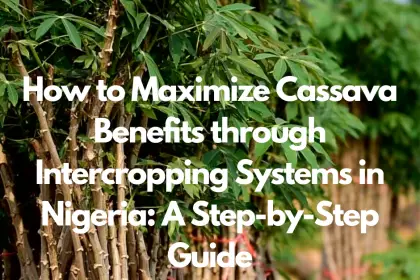Cassava production in Nigeria stands as a pivotal sector, with the country being the world’s largest cassava producer, an annual output surpassing 34 million tonnes. This agricultural triumph has been on an upwards trajectory for over two decades, not just in the area cultivated but also in yield per hectare, underlining the significance of cassava farming in Nigeria. However, the journey is not without its challenges. Traditional cultivation methods like rotation and fallow systems, aimed at maintaining soil fertility, face constraints due to population pressure and diminished land availability, making sustainable practices a necessity.
In the realm of organic cassava farming, there lies a plethora of opportunities waiting to be explored. Despite the hurdles such as limited access to inorganic fertilizers and continuous cropping reducing soil fertility, the shift towards organic agricultural practices offers a beacon of hope. Additionally, the role of women in cassava production, processing, and marketing is monumental, contributing significantly to the agricultural labor force. This transformation not only promises an environmentally friendly approach but also opens the door to new market opportunities, laying the groundwork for discussions on technological innovations, market opportunities, and comprehensive policy recommendations in the subsequent sections.
The Global Rise of Organic Agriculture
The global landscape of agriculture is witnessing a significant shift towards organic practices, with cassava production playing a pivotal role in this transformation. Introduced to Africa in the late 16th century by the Portuguese, cassava has become a staple and a potential cash crop across many African nations. Recognizing its importance, organizations like the International Fund for Agricultural Development (IFAD) and the International Institute of Tropical Agriculture (IITA) are spearheading a global strategy for its development, particularly in sub-Saharan Africa.
- Global Organic Agriculture Growth:
-
- Area and Sales Increase: From 2000 to 2021, the global organic area expanded by over 400%, while organic retail sales soared by more than 700%.
- Organic Management: By 2021, nearly 77 million hectares, or 1.6% of global agricultural land, were under organic management.
- Market Dynamics: Despite geopolitical conflicts and rising food prices impacting the sector, the organic market’s resilience is evident in its continued growth, with global retail sales reaching almost 125 billion euros in 2021.
- European Market Trends:
-
- Farmland Expansion: Europe saw an 8% increase in organic farmland in 2021, with a continued expansion in 2022. The organic area share in the European Union reached approximately 17 million hectares by 2022.
- Consumer Shifts: Challenges such as inflation and the cost of living have impacted consumer behavior, with some turning to discounters for organic products. However, countries like the Netherlands, Austria, and Italy witnessed further market growth.
This upward trajectory in organic agriculture, underscored by consumer awareness and government support, sets a promising stage for organic cassava farming. The shift towards organic practices is not just a trend but a sustainable approach to agriculture that benefits the environment, producers, and consumers alike.
Challenges in Organic Cassava Cultivation
In the quest for sustainable cassava production, farmers in Ebonyi State, Nigeria, have adopted several strategies to combat the adversities brought by climate change. These include:
- Planting Improved Cassava Varieties: To enhance resistance against diseases and pests, thereby ensuring better yields.
- Insuring Farms: Offering a safety net against catastrophic losses due to natural disasters or crop failures.
- Diversifying Crops: By planting different crops alongside cassava, farmers mitigate risks and improve soil health.
However, the path to sustainable organic cassava farming is fraught with challenges:
- Pests and Diseases: Cassava mosaic disease and cassava brown streak disease are prevalent threats that can decimate yields.
- Access to Quality Planting Material: The scarcity of healthy cassava cuttings impedes the establishment of robust cassava crops.
- Credit Accessibility: Many smallholder farmers struggle to secure loans for purchasing essential inputs, affecting their ability to invest in their farms.
Moreover, infrastructural deficiencies such as poor transportation and inadequate storage facilities exacerbate post-harvest losses and restrict market access. Coupled with changing weather patterns and outdated farming practices, these challenges underscore the need for concerted efforts to bolster cassava farming in Nigeria.
Technological Innovations and Organic Cassava Farming
Incorporating technological innovations into organic cassava farming presents a transformative approach to enhancing production and sustainability. The National Cassava R&D Strategy outlines key strategic imperatives crucial for advancing cassava production organically:
- Germplasm Acquisition and Breeding: Focusing on the collection, evaluation, and conservation of cassava varieties to ensure resilient and high-yielding crops.
- Agronomy and Crop Protection: Developing sustainable farming practices that mitigate pests and diseases while promoting soil health.
- Mechanization and Agro-processing: Leveraging technology to streamline cassava farming and processing, reducing labor and increasing efficiency.
Soil Management Techniques:
- Pre-planting soil preparation involves adding limestone to acidic soils (2 to 4 tons per hectare) 3-4 months before planting.
- Conducting soil analysis is imperative to detect and mitigate residual chemical substances, ensuring a truly organic cultivation environment.
Planting Strategies:
- Selecting cuttings from healthy, robust plants (2 to 4 cm thick) is essential for strong crop establishment.
- Optimal planting times and spacing vary by variety; however, a general guideline is at the onset of the warm season with spacing for non-branching (75 x 75 cm) and branching varieties (90 x 90 cm).
Innovative Farming Practices:
- Utilizing biochar technology in intercropping cassava with maize or groundnuts can significantly enhance soil fertility and maintain yields. This practice has shown to increase soil carbon, potassium, cation exchange capacity (CEC), and water availability, demonstrating the potential for biochar to revolutionize organic cassava farming.
Market Opportunities for Organic Cassava
The burgeoning market for organic cassava and its derivatives presents a plethora of opportunities for farmers and businesses alike. With cassava’s adaptability to marginal soils and its significance in sub-Saharan Africa for income, food, and nutrition security, the stage is set for a substantial market evolution driven by several key factors:
- Market Drivers:
-
- Population growth and urbanization are propelling demand.
- Changing consumer preferences towards organic products.
- Increasing awareness of health benefits associated with organic cassava flour.
- Industrial Demand:
-
- The food and beverage sector leads with a 42% market share in cassava starch consumption.
- Paper, textile, and adhesives industries follow closely, highlighting diverse industrial applications.
- The anticipated growth in organic cassava starch market, valued at $3 billion in 2022, to $4.4 billion by 2032, underscores the expanding industrial demand.
- Regional Highlights:
-
- Asia-Pacific stands out as a significant player, with the highest market share in 2022, driven by key factors like cassava production, trade, and processing dynamics.
- The market is segmented across North America, Europe, Asia-Pacific, South America, Middle East, and Africa, indicating a global reach and varied consumer bases.
This landscape suggests that investing in organic cassava production not only aligns with sustainable agricultural practices but also taps into a growing market with diverse applications across industries.
Case Studies: Success Stories in Organic Cassava Farming
In Cambodia, Thai Wah Public Company Limited has taken a significant step towards sustainable agriculture by investing in organic cassava production. This initiative, in partnership with local farmer cooperatives, showcases a successful model of corporate and community collaboration. The project not only enhances cassava yields but also promotes organic farming practices, setting a precedent for similar ventures in the region.
- Key Highlights from Nigeria:
-
- Production Scale: Nigeria leads with an annual output of over 34 million tonnes, primarily by small-scale farmers.
- Consumption: Predominantly for human consumption, with less than 5% directed towards industrial use.
- Women’s Involvement: Women contribute significantly, accounting for 58-67% of the agricultural labor force in key zones.
The Philippines’ Gahung-Gahung Cassava Program stands as a beacon of hope for upland subsistence farmers. This poverty alleviation initiative combines sustainable farming techniques with a microfinance scheme to ensure food security and improve living conditions. The program has engaged over 2,000 farmers and employs conservation tillage, reducing carbon emissions and enhancing soil health through the retention of crop residues. This approach not only stabilizes the ecosystem but also sets a sustainable path forward for organic cassava farming.
Future Directions and Policy Recommendations
To foster the growth and sustainability of organic cassava farming, a multi-faceted approach involving investors, governments, and the farming community is essential. Here are strategic recommendations:
Investor Initiatives:
- Market Analysis: Prior to engaging with smallholder farmers, investors should thoroughly analyze future market trends to ensure the viability of introducing new cassava crops.
- Partnerships and Investment: Encourage partnerships with research organizations and leverage local knowledge to offer investment opportunities that address the sector’s challenges.
Government Support and Policies:
- Incentives for Sustainable Practices: Governments must incentivize both farmers and companies to adopt environmentally sustainable and climate-smart agricultural practices.
- Policy Reformation and Support: Addressing the concerns raised by cassava farmers in Ikorodu, Lagos State, such as policy instability and inadequate governmental support, is crucial. Recommendations include reforming cassava policies, promoting the commercialization of the crop, and providing high-yield cassava stems.
Community and Farmer Engagement:
- Training and Development: Implement training programs to educate farmers on modern, sustainable farming techniques and the benefits of cassava farming. This includes promoting high-yielding and disease-resistant varieties.
- Infrastructure and Market Access: Improve rural infrastructure to reduce post-harvest losses and facilitate market access. Encourage the establishment of community-based nurseries for quality planting material distribution.
By implementing these strategies, stakeholders can significantly contribute to achieving Sustainable Development Goal 2, promoting sustainable agriculture, and ensuring food security through the enhancement of organic cassava farming.
Conclusion
Through an analytical journey into the realms of organic cassava farming, this article has highlighted the intricate tapestry of challenges and opportunities inherent in Nigeria’s agricultural landscape. It meticulously explored the transition towards organic practices, emphasizing not only the environmental but also the economic vertices that shape the sector’s future. The comprehensive discourse underscored the pivotal role of technological innovations, market dynamics, and community-driven case studies, demonstrating a nuanced understanding of how organic cassava farming could revolutionize sustainable agriculture in Nigeria and beyond.
As the discourse on organic cassava farming continues to evolve, it beckons stakeholders – from policymakers to local farmers – to forge collaborative efforts that address the nuanced challenges while capitalizing on the burgeoning opportunities. The future of cassava farming hinges on adopting sustainable practices, advancing research, and streamlining market access, which together promise to uplift communities, fortify food security, and pave the way for environmental stewardship. In doing so, we not only commit to the betterment of today’s agricultural practices but also safeguard a legacy of sustainability for generations to come, marking a shift towards a more resilient and prosperous agricultural future.
FAQs
What are the common difficulties encountered in growing cassava?
Cassava farmers face several challenges, including the management of pests and diseases, obtaining high-quality planting materials, coping with unpredictable weather conditions, navigating market access and price volatility, and dealing with the storage and transport of the harvested cassava.
How can cassava be utilized in various sectors?
Cassava presents numerous opportunities beyond being a basic food item. Its versatility extends to uses in food preparation and snacking, animal feed production, industrial processes, and even the generation of bioenergy. It also has potential applications in pharmaceuticals and the creation of bio-based packaging materials.
What are the main limitations in producing cassava?
One of the primary limitations in cassava production is its roots’ tendency to deteriorate quickly after harvest. This rapid post-harvest spoilage restricts the ability to store cassava roots in their fresh state for an extended period, typically not more than a few days, before they must be processed.
What constitutes best practices for cultivating cassava?
For optimal cassava cultivation, it is important to have an annual rainfall of at least 1000 mm, with a consistent rainy season lasting at least 6 months and monthly rainfall of 50 mm or more. The soil should be well-drained, deep (at least 30 cm), and free from sand, clay, stones, or salinity. In areas prone to waterlogging, cassava should be planted on raised mounds or ridges to prevent root rot.

